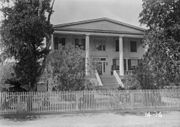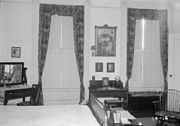Orange Hall (St. Marys, Georgia)
Orange Hall St. Marys, Georgia | |
 Orange Hall | |
| Location | 311 Osborne St., St. Marys, Georgia, United States, within the St. Marys Historic District |
|---|---|
| Coordinates | 30°43′28″N 81°32′53″W / 30.72431°N 81.54811°W |
| Built | 1830 |
| Architectural style | Greek Revival |
| Part of | St. Marys Historic District (Georgia) (ID76000609) |
| NRHP reference No. | 73000613[1] |
| Added to NRHP | May 7, 1973 |
Orange Hall c. 1830, is located at 311 Osborne St., St. Marys, Georgia, United States, located within the St. Marys Historic District in Camden County and was listed on the National Register of Historic Places on May 7, 1973.[1] In 2011, Orange Hall was added to the list of the state of Georgia's ten most endangered historic sites by the Georgia Trust for Historic Preservation.[2]
Historical significance
[edit]Orange Hall is a good example of the temple-form Greek Revival dwelling.[3] A frame building with clapboard siding, it is among the first structures of Greek Revival design in America.[4] The name originated from the orange trees that surrounded the house. Other details include: two stories, a gabled roof, interior chimneys, front center entrance with side lights and transom surmounted by low pedimented lintel, front tetrastyle prostyle Doric pedimented portico supported by projecting basement, and a rear center recessed two-story porch.
Historic American Buildings Survey
[edit]The Library of Congress, Historic American Buildings Survey/Historic American Engineering Record has the following data recorded regarding Orange Hall.[5] Owner in 1934: S.C. Townsend, Date of Erection: 1810–1815, Architect: No record, Builder: No record, Built for the Rev. Horace Southworth Pratt, a Presbyterian minister.
Architectural notes
[edit]This building of the Early Republican period is a Doric prostyle temple. The pediment is flattened and the columns are widely spaced. At the rear end is a superimposed inset portico, one porch above the other.
The brink basement storey is stuccoed and has stucco quoins of inch projection. In the basement used to be the old kitchen, now marked by its whitewashed walls, a herringbone brick floor pattern and a Dutch oven. The old Dining Room was under the front portico.
-
Orange Hall c.1838
-
Historic district sign near Orange Hall
-
Front view from 1934
-
Side view from 1934
-
Bedroom
-
Interior stairwell
-
Rear view from 1934
-
Angle view in 2022
-
Sign at Orange Hall
History
[edit]Construction and original ownership
[edit]The property on which Orange Hall stands today was originally granted to William Ashley, one of the twenty founders of St. Marys, in 1787. Phineas Miller is listed as the owner of the lot when it was sold to Ethan Clarke in 1803. In 1826, the lot was divided and the northern half was sold to the wealthy John Wood and Horace Southworth Pratt, a Presbyterian minister. Pratt had arrived in St. Marys around 1820, established the First Presbyterian Church of St. Marys in 1822, and married Wood's daughter, Jane, in 1823.
In 1829, before construction of Orange Hall began, Pratt's wife, Jane, died. Pratt remained in St. Marys and remarried a few years later. In 1838, construction of Orange hall completed, with master carpenter Isaac Slayton listed as the builder. In 1839, Pratt, a Yale and Princeton graduate, took a position as a professor at the University of Alabama and left Orange Hall behind. General Duncan Lamont Clinch is thought to have lived there when Pratt left for Alabama. Pratt died in 1840 before he could return to Orange Hall.[6]
Succession of ownership
[edit]The property was sold in public auction in 1846 to James Mongin Smith, a wealthy planter from Beaufort, South Carolina. Subsequent owners include:
1856 – Francis Adams, Mayor of St. Marys
1866 – Elizabeth and Joseph Ryals
1869 – Silas Fordham, a town supervisor and farmer from New York who used the home as a winter retreat
1911 – Joel Lee Sweat, a judge, representative, and state senator from Ware County.
1919 – James Howard Becker, an automobile manufacturer
1925 – George and Ruth Fryhofer, who spent little time in St. Marys and briefly lost possession to Camden County due to failure to pay taxes
1933 – Effie G. Townsend, who fell upon hard times in World War II and converted the upper floors to apartments
1949 – Faye Kelly, daughter of Effie Townsend, who severed two parcels from the original lot
1951 – St Marys Kraft Corporation, which bought to house paper mill employees for 10 years
1961 – City of St. Marys, which agreed to rename the building the "Gilman Civic Center" and use it as a library
Preservation
[edit]Orange Hall fell into disrepair during the 1960s. In 1975, the City of St. Marys, the local Chamber of Commerce, and the Gilman Paper Company, assisted by numerous clubs and individuals, initiated an effort to preserve and restore the building. Work began in 1978 using skilled but unemployed high school students because the historic grant required the use of unemployed laborers, which the coordinators were unsuccessful at organizing. The project was highly successful and completed in 1980.
In 1982, Naval Reserve Commander John K. Mott completed an extensive restoration plan for the property. Due to limited available of funding, very few of his recommendations were implemented.
In 1983, a group of Navy Reservist Seabees took part in repair and reconstruction activities during their summer active duty session.
See also
[edit]- St. Marys, Georgia
- St. Marys Historic District (St. Marys, Georgia)
- National Register of Historic Places listings in Camden County, Georgia
- Cumberland Island
References
[edit]- ^ a b "National Register Information System". National Register of Historic Places. National Park Service. March 13, 2009.
- ^ The Atlanta Journal-Constitution, Oct. 26. 2011
- ^ Best Books on (1940). Georgia, a Guide to Its Towns and Countryside. Works Progress Administration. p. 291. ISBN 978-1-62376-010-6.
- ^ Gordon Jackson (2016). "Mending fences project scheduled at Orange Hall". The Brunswick News. Brunswick News Publishing Co. Retrieved August 2, 2020.
- ^ http://memory.loc.gov/cgi-bin/query/r?ammem/hh:@field(NUMBER+@band(GA0296))
- ^ Orange Hall Historic Structure Report, April 2006
Further reading
[edit]- Gleason, David King (1987). Antebellum Homes of Georgia. Louisiana State University Press. p. 14. ISBN 978-0-8071-1432-2.
External links
[edit] Media related to Orange Hall (St. Marys, Georgia) at Wikimedia Commons
Media related to Orange Hall (St. Marys, Georgia) at Wikimedia Commons
Orange Hall Board of Directors official site. www.orangehall.net
- Houses on the National Register of Historic Places in Georgia (U.S. state)
- Houses in Camden County, Georgia
- St. Marys, Georgia
- Houses completed in 1838
- 1838 establishments in Georgia (U.S. state)
- National Register of Historic Places in Camden County, Georgia
- Historic district contributing properties in Georgia (U.S. state)











